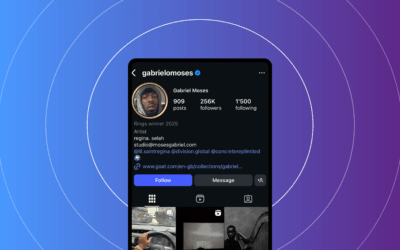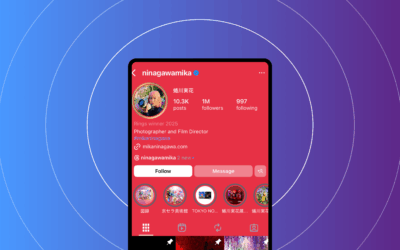How Do Influencers Make Money?
How do influencers make money? The influencer marketing industry is set to explode to $32.55 billion in 2025—a staggering 35% jump that signals unprecedented opportunity for creators ready to diversify their income streams.
Take Sarah, a lifestyle influencer who started with brand partnerships but quickly expanded into affiliate marketing, digital courses, and her own product line. Within two years, she transformed her single revenue source into six different income streams, reducing her financial risk while tripling her earnings.
This strategic approach isn’t uncommon—70% of successful influencers now maintain multiple revenue sources, refusing to rely solely on brand collaborations. With over 60% of brands planning influencer partnerships in 2025 and generating $4.12 for every dollar spent, the industry has evolved from an experimental tactic to a core marketing growth engine.
For content creators and marketing professionals, this represents more than just numbers—it’s a blueprint for sustainable success in an increasingly competitive digital landscape where diversification isn’t just smart, it’s essential.
The Foundation of Influencer Income
Brand partnerships form the cornerstone of influencer revenue, establishing themselves as the dominant income source across all creator tiers. With 85% of marketers allocating dedicated budgets for influencer collaborations, this revenue stream has evolved into a sophisticated ecosystem that drives the creator economy forward.
Revenue Stream Breakdown
|
Revenue Source |
Percentage of Total Income |
|
Brand Partnerships |
65% |
|
Affiliate Marketing |
20% |
|
Content Creation Services |
8% |
|
Product Sales |
4% |
|
Other Sources |
3% |
Instagram leads the charge in creator partnerships, with 72% of marketers leveraging the platform for brand collaborations. This dominance reflects the platform’s visual-first approach and robust creator tools that facilitate seamless brand integrations.
Key Partnership Evolution Trends
- Creator Tier Distribution: Nano influencers command 44% of brand partnerships, while micro influencers secure 26%, demonstrating brands’ preference for authentic, niche audience engagement
- Affiliate Marketing Surge: The affiliate marketing sector is projected to reach $1.3 billion by 2025, representing unprecedented growth in performance-based creator compensation
- Performance-Based Models: Brands increasingly favor ROI-driven partnerships, moving beyond vanity metrics to focus on conversion rates and measurable business impact
- Financial Returns: Influencer marketing delivers exceptional value, generating an average ROI of $4.12 for every $1 invested, making it one of the most cost-effective marketing channels
The foundation of influencer income has shifted from traditional advertising models to collaborative partnerships that prioritize authentic storytelling and audience engagement. This evolution reflects marketers’ recognition that creators possess unique abilities to connect with audiences in ways that traditional advertising cannot replicate.
As the industry matures, successful influencers focus on building long-term brand relationships rather than pursuing one-off collaborations. This strategic approach ensures sustainable income streams while maintaining audience trust and engagement across all partnership activities.
Where the Money Actually Comes From
Platform-specific monetization strategies have transformed dramatically, with each social media channel offering distinct revenue opportunities for content creators.
TikTok Creator Rewards: The New Revenue Leader
TikTok has revolutionized creator compensation with its Creator Rewards program, offering $4-8 per 1,000 views—a massive improvement from the previous Creator Fund’s meager $0.20-0.40 rate. This 20x increase positions TikTok as one of the most lucrative platforms for short-form content creators.
To qualify, creators must be 18 or older, maintain 10,000 followers, and generate 100,000 views within 30 days. The program rewards engaging content that keeps audiences watching, making it particularly attractive for viral content creators.
YouTube Partner Program: The Established Giant
YouTube maintains its industry-standard 55% ad revenue share with creators, translating to $1-10 per 1,000 monetized views depending on audience demographics and content niche. Tech and finance channels typically earn higher rates than entertainment content.
The platform requires creators to reach 1,000 subscribers and accumulate 4,000 watch hours before monetization begins. Despite stricter requirements, YouTube offers the most transparent and consistent revenue model in the industry.
Instagram’s Diversified Approach
Instagram takes a less direct monetization route, focusing on affiliate programs, live badges, and Reels Play Bonuses. The platform emphasizes creator-brand partnerships rather than direct platform payments, making revenue streams less predictable but potentially more lucrative for established influencers.
Instagram’s monetization requirements vary by feature, with some programs requiring 10,000 followers while others remain invitation-only.
Platform Comparison Overview
|
Platform |
Payout Rate |
Requirements |
Revenue Model |
|
TikTok |
$4-8/1K views |
18+, 10K followers, 100K monthly views |
Creator Rewards |
|
YouTube |
$1-10/1K views |
1K subscribers, 4K watch hours |
55% ad revenue share |
|
|
Variable |
Varies by program |
Affiliate/brand partnerships |
The Bottom Line
TikTok currently offers the highest direct payouts for views, making it attractive for new creators seeking immediate monetization. YouTube provides stability and transparency for long-term content strategies, while Instagram excels in brand partnership opportunities. Successful creators often diversify across all three platforms, leveraging each platform’s unique strengths to maximize their overall revenue potential.
Small Audiences, Big Opportunities
The influencer marketing landscape has shifted dramatically, with brands increasingly recognizing that smaller creators deliver superior results. Nano influencers (1K-15K followers) now secure 44% of brand collaborations, while micro influencers (10K-75K followers) claim 26% of partnerships, collectively dominating the market over their larger counterparts.
Why Brands Choose Smaller Creators:
- Higher Engagement Rates: Nano influencers achieve impressive engagement rates of 1.73% to 4.39%, significantly outperforming macro and mega influencers who typically see below 1-2% engagement
- Cost-Effective Partnerships: Smaller creators offer affordable collaboration opportunities, allowing brands to work with multiple influencers within their budget constraints
- Niche Specialization: These creators often focus on specific topics, providing brands access to highly targeted audiences with genuine interest in relevant products
- Authentic Community Building: Their intimate follower relationships translate to higher trust levels and more meaningful brand endorsements
Engagement Rate Comparison:
- Nano influencers: 1.73% – 4.39%
- Micro influencers: 0.68% – 4%
- Macro/Mega influencers: Below 1-2%
Consider a fitness nano influencer with 8,000 followers promoting workout equipment. Their audience actively seeks fitness advice, resulting in higher conversion rates compared to a celebrity endorsement reaching millions of disengaged viewers.
Community-Based Monetization Opportunities:
Smaller creators can leverage their tight-knit communities through exclusive product launches, personalized recommendations, and direct audience feedback. This approach enables sustainable revenue streams while maintaining authentic relationships with followers.
For aspiring influencers and brands alike, these statistics prove that influence isn’t about follower count—it’s about genuine connection and engagement. Smart brands are investing in these authentic voices, creating mutually beneficial partnerships that drive real results.
Beyond the Single Income Source
Smart influencers understand that relying on a single revenue stream creates unnecessary risk. Research shows 70% of successful influencers maintain multiple income sources, positioning themselves for sustained growth as marketing budgets continue expanding.
Building Diversified Revenue Streams
Personal Brand Development Successful creators focus on building authentic brand value that transcends platform algorithms. They establish expertise in specific niches, creating trust that translates across multiple monetization channels.
Digital Product Creation Content creators increasingly develop courses, ebooks, templates, and subscription services. These assets generate passive income while leveraging existing audience relationships.
Investment Strategies Forward-thinking influencers reinvest earnings into stocks, real estate, or business ventures. Diversifying beyond content creation provides financial stability during market fluctuations.
Step-by-Step Diversification Guide
- Audit Current Income Sources – List all revenue streams and identify dependencies
- Identify Skill-Based Opportunities – Leverage expertise for consulting, coaching, or product development
- Explore Affiliate Partnerships – With $1.3 billion projected growth, strategic partnerships offer significant potential
- Develop Intellectual Property – Create downloadable resources, courses, or licensing opportunities
- Build Email Lists – Own direct audience access independent of social platforms
- Establish Business Structures – Set up LLCs or corporations for tax optimization
Legal and Tax Considerations
Professional influencers work with accountants familiar with creator economics. They establish proper business entities, track expenses meticulously, and understand quarterly tax obligations. Separate business and personal finances while maintaining detailed records of all income sources.
Long-term Partnership Focus As brands shift toward sustained collaborations over one-off campaigns, creators who demonstrate business acumen and revenue diversification become more attractive partners. They offer stability and professionalism that brands increasingly value.
Successful diversification requires strategic planning, consistent execution, and professional guidance. Creators who build multiple income streams create resilient businesses that thrive regardless of platform changes or market conditions.
What’s Next in Creator Monetization
The creator monetization landscape is undergoing a fundamental transformation as artificial intelligence and blockchain technologies reshape how influencers connect with brands and audiences. By 2025-2026, several technological frameworks will define the next generation of creator economy platforms.
AI-powered matching platforms are revolutionizing brand-creator partnerships by analyzing audience demographics, engagement patterns, and content performance to create optimal collaborations. These sophisticated algorithms eliminate guesswork, ensuring brands connect with creators whose audiences align perfectly with their target markets.
Blockchain technology is introducing unprecedented transparency through automated sponsorship marketplaces. Smart contracts will enable creators to receive instant payments upon meeting predetermined performance metrics, while brands gain access to immutable campaign data and authentic engagement verification.
Advanced attribution models are shifting focus from vanity metrics to measurable ROI. Machine learning algorithms now track customer journeys across multiple touchpoints, providing brands with precise data on how creator content drives conversions and lifetime customer value.
Web3 opportunities are expanding rapidly, with creator coins and NFTs offering new revenue streams. These digital assets allow creators to monetize their personal brand directly, selling exclusive content, experiences, or community access to their most dedicated followers.
Integrated e-commerce solutions are streamlining the path from content to purchase. Live shopping features, embedded product catalogs, and seamless checkout experiences are transforming social media platforms into comprehensive retail environments.
The $97.55 billion influencer marketing projection by 2030 reflects this technological evolution. Platforms that successfully integrate AI matching, blockchain verification, advanced analytics, and Web3 capabilities will dominate the creator economy, while creators who adapt to these technologies will unlock unprecedented monetization opportunities in an increasingly data-driven marketplace.
Conclusion
The creator economy stands at a pivotal moment, with the influencer marketing industry reaching an unprecedented $32.55 billion in 2025. Success in this evolving landscape demands more than follower counts—it requires strategic diversification, authentic engagement, and adaptability to technological advances.
Modern creators who thrive understand that multiple revenue streams provide stability and growth potential. They prioritize building genuine connections with their audience while leveraging data-driven strategies that demonstrate measurable ROI to brand partners. The shift toward authenticity over vanity metrics has created opportunities for creators at every level to monetize their influence effectively.
Technology continues reshaping the creator economy, offering new platforms and monetization tools that savvy influencers can leverage for sustainable income generation. Those who embrace these changes while maintaining their authentic voice position themselves for long-term success.
Take Action Today: Evaluate your current revenue streams and identify gaps in your monetization strategy. Are you relying too heavily on one income source? Consider exploring affiliate marketing, digital products, sponsored content, or platform-specific monetization features. Start small, test different approaches, and scale what works best for your audience and niche. The time to diversify is now—your future financial stability depends on it.
Influencer Marketing Articles
Actionable tips to get more success with influencer marketing campaigns
Who is Gabriel Moses?
Discover Gabriel Moses, the London-born artist blending fashion, music, and heritage into striking visual narratives. From Dior to Johnnie Walker, see why he’s shaping culture.
Who is Mika Ninagawa?
Discover Mika Ninagawa, Tokyo’s visionary photographer and film director celebrated for her vivid art, bold storytelling, and win at Instagram Rings 2025.
Influencer Price List: What Brands Pay in 2025 & 2026
An influencer price list is the working set of fees and terms creators (or their agents) provide — the baseline for budgeting, negotiating, and forecasting influencer campaigns.






